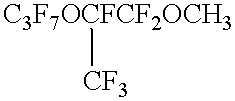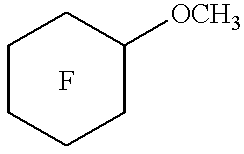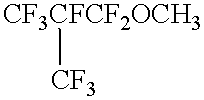Fluorinated solvent compositions containing hydrogen fluoride
a technology of fluorinated solvent and composition, which is applied in the preparation of detergent mixture composition, inorganic non-surface active detergent composition, detergent compounding agent, etc., can solve the problems of stiction, particles are not easily removed from the device, and affect the performance of the device, etc., and achieve the effect of not being easily recovered
- Summary
- Abstract
- Description
- Claims
- Application Information
AI Technical Summary
Benefits of technology
Problems solved by technology
Method used
Image
Examples
examples 1-7
Cleaning Compositions A-I, having variations in the composition of each component (i.e., the fluorinated solvent, the anhydrous hydrogen fluoride or complex thereof, and the co-solvent) were evaluated for their ability to clean a test silicon wafer using the Wafer Cleaning / Water Repellency Test Procedure. Results from these evaluations, shown as qualitative water repellencies, are presented in TABLE 1.
The repellency data in TABLE 1 indicate that the compositions containing anhydrous HF (Examples 1-4) all demonstrated good etch cleaning performance, while the composition containing the anhydrous pyridine HF complex (Example 5) performed but not as well. Compositions containing anhydrous HF complexes of triethylamine and ammonia (Examples 6 and 7, respectively), demonstrated etching. Both isopropyl and ethyl alcohol performed effectively as co-solvents in the etch cleaning formulations.
All the fluorinated solvents listed in TABLE 1 (two hydrofluoroethers and one hydrofluorocarbon--all...
example 16
Results and Comparative Examples C2-C4 are presented in TABLE 3. The percentages of HF, HFE-7100 and IPA and for each cleaning composition are also depicted.
The data in TABLE 3 show that levels of IPA at 2.7% or more effectively quenched the etch cleaning process, even when levels of HF were as high as 1.23%.
PUM
| Property | Measurement | Unit |
|---|---|---|
| Fraction | aaaaa | aaaaa |
| Fraction | aaaaa | aaaaa |
| Angle | aaaaa | aaaaa |
Abstract
Description
Claims
Application Information
 Login to View More
Login to View More - R&D
- Intellectual Property
- Life Sciences
- Materials
- Tech Scout
- Unparalleled Data Quality
- Higher Quality Content
- 60% Fewer Hallucinations
Browse by: Latest US Patents, China's latest patents, Technical Efficacy Thesaurus, Application Domain, Technology Topic, Popular Technical Reports.
© 2025 PatSnap. All rights reserved.Legal|Privacy policy|Modern Slavery Act Transparency Statement|Sitemap|About US| Contact US: help@patsnap.com



